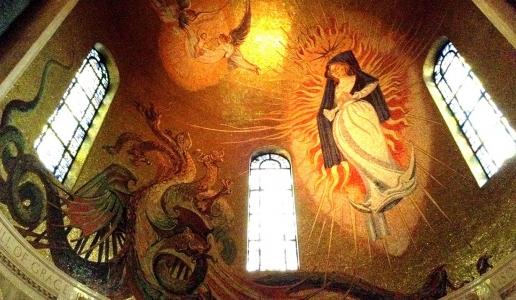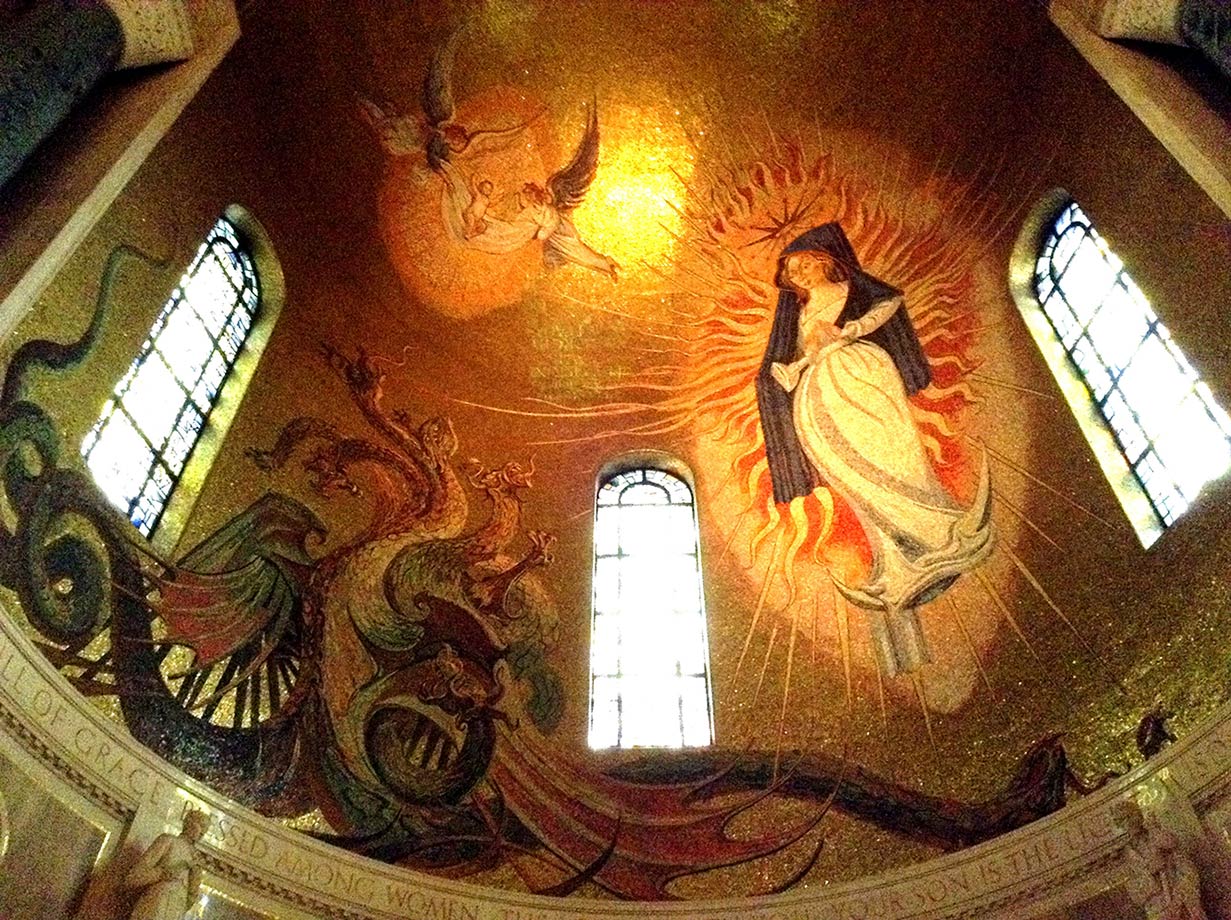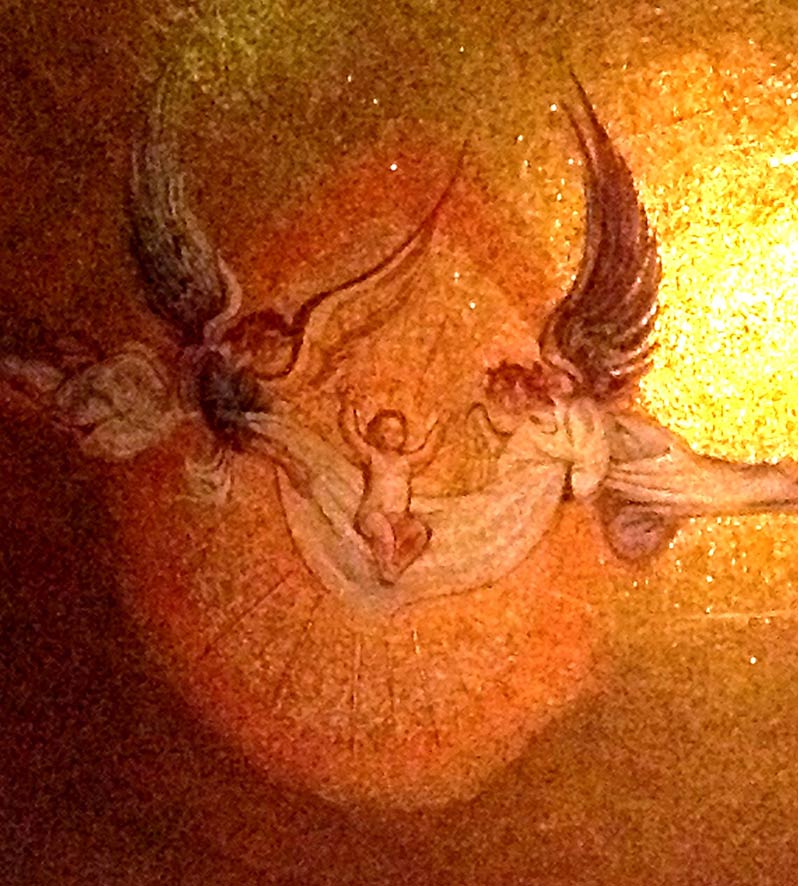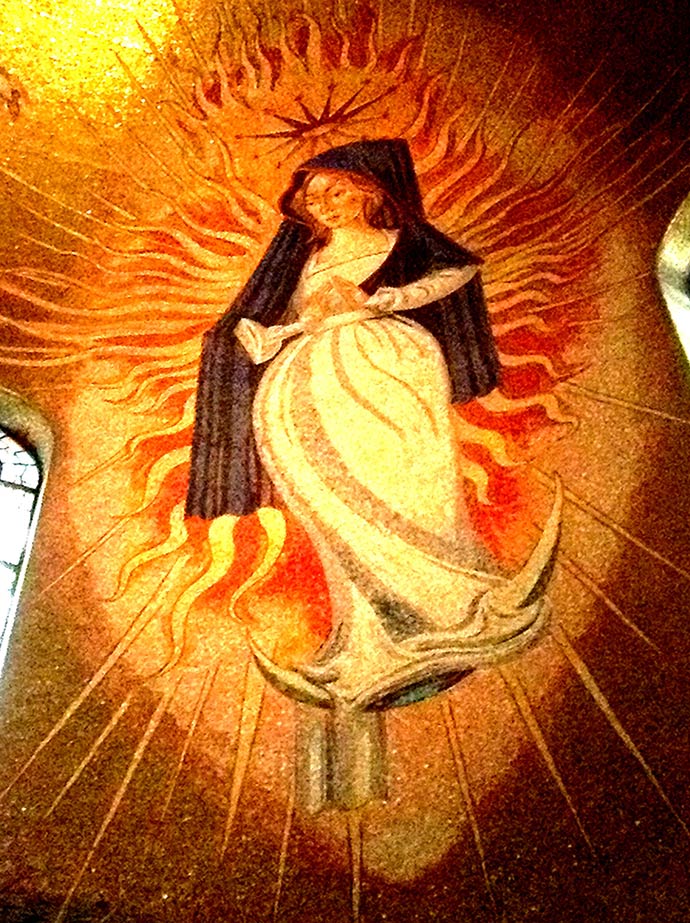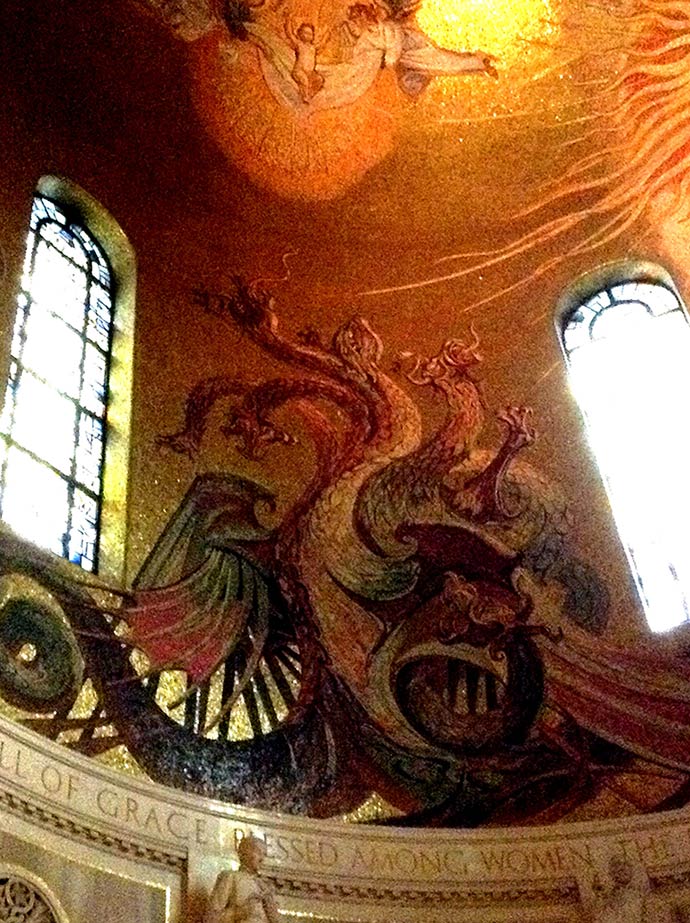The Woman Clothed with the Sun Mosaic
Basilica of the National Shrine of the Immaculate Conception
Location: 400 Michigan Ave NE, Washington D.C. 20017
Metro: Red line to Brookland/CUA; the Basilica also has free parking.
by Allison Gliot
Prayer to Defeat the Work of Satan (the Pieta Prayer Book 18):
O Divine Eternal Father, in union with Your Divine Son and the Holy Spirit and through the Immaculate Heart of Mary, I beg You to destroy the power of Your greatest enemy— the evil spirits. Cast them into the deepest recesses of hell and chain them there forever! Take possession of Your Kingdom which You have created and which is rightfully Yours.
Heavenly Father, give us the reign of the Sacred Heart of Jesus and the Immaculate Heart of Mary. I repeat this prayer out of pure love for you, with every beat of my heart and with every breath I take. Amen.
Covering 3,570 feet, the Woman Clothed with the Sun mosaic decorating the West Apse of the Basilica of the National Shrine of the Immaculate Conception (fig. 1) was originally designed by Joseph L. Young and manufactured by the Ravenna Mosaic Co. (Rohling 86). A gift from the Society of Jesus, the cartoons for it were painted in 1964, though the mosaic itself was begun a year later and not fully completed until 1967 (Mosaics of the National Shrine 62). It depicts the following scene from the Book of Revelation:
1 A great sign appeared in the sky, a woman clothed with the sun, with the moon under her feet, and on her head a crown of twelve stars. 2 She was with child and wailed aloud in pain as she labored to give birth. 3 Then another sign appeared in the sky; it was a huge red dragon, with seven heads and ten horns, and on its heads were seven diadems. 4 Its tail swept away a third of the stars in the sky and hurled them down to the earth. Then the dragon stood before the woman about to give birth, to devour her child when she gave birth. 5 She gave birth to a son, a male child, destined to rule all the nations with an iron rod. Her child was caught up to God and his throne. 6 The woman herself fled into the desert where she had a place prepared by God, that there she might be taken care of for twelve hundred and sixty days (12:1-6).
This mosaic draws a connection between the “woman clothed with the sun” and Mary, while both Mary and the woman are understood to be symbols of the Church (Mosaics of the National Shrine 10). It is Mary who gave birth to Jesus, the child “destined to rule all the nations with an iron rod” (Rev 12:5) and who is portrayed in the mosaic as being carried up to heaven by two angels (fig. 2). She is clothed with the sun because she possesses divine wisdom, and the twelve stars of her crown symbolize the twelve patriarchs and the twelve apostles (fig. 3) (Navarre 80-81). The child being brought to up to God can be interpreted as a reference to Christ’s ascension (Johnson 1682), while the woman fleeing to the desert after the birth of her child shows that Mary has a special union with God and was particularly protected by God from Satan’s powers (Navarre 82). The dragon (fig. 4) represents the devil, and is portrayed with imagery from the Old Testament: it is a serpent as from Genesis, with the ten horns standing for the enemies of Israel (Navarre 81) and the diadems symbolizing Satan’s sovereignty over this world (Johnson 1682). The dragon is hideous to show the true nature of evil, and it writhes away from the woman clothed with the sun and her child, because it recognizes that the child, Jesus Christ, will ultimately defeat it (Navarre 82), thereby dispelling evil from the world.
Mosaics are used throughout the shrine because they were traditionally the decorations used in the earliest churches (Mosaics of the National Shrine 8). The Woman Clothed with the Sun is done in a Byzantine style to match the architecture of the upper church, striking a careful balance between realism and decorative stylization (Mosaics of the National Shrine 13-14). The images are realistically three-dimensional with discernible shading and depth, while the figures are stylistically depicted in a way that contrasts flowing curves with sharp points and straight edges. The incorporation of realism and stylization in mosaics was a trend which began in the late nineteenth century as a reaction against earlier Baroque mosaics, such as those in the domes of St. Peter’s Basilica, that often blended illusion and reality (Mosaics of the National Shrine 13-14). Mary is regularly shown in art with imagery that draws from the ‘woman clothed with the sun;’ for example, she is often shown standing on a moon and wearing a crown of twelve stars with rays of light radiating out from behind her, particularly in art that depicts the Immaculate Conception. However, The Woman Clothed with the Sun mosaic is quite unique, not only because it is in a national pilgrimage site and the largest Catholic church in the U.S.A., but also because there is only one other mosaic in the world depicting this scene, in the Presentation Chapel at St. Peter’s Basilica (Mosaics of the National Shrine 10). The mosaic in St. Peter’s, created in the early eighteenth century, is quite different than the one in the Shrine because it is done in a Baroque instead of Byzantine style and portrays the woman being saved by God as an avenging angel casts the dragon out of heaven (Mosaics of St. Peter’s 24).
The mosaic of the Woman Clothed with the Sun serves to remind the viewer of Mary’s special role in salvation history, particularly as the mother of Jesus Christ: she bears the one who will ultimately defeat evil in the world. Let us prayerfully ask Mary to lead us to her Son so that we may be guarded from the snares of the devil and victorious with her at the end of time when evil is defeated by Christ once and for all.
For more information visit National Shrine of the Immaculate Conception.
Works Cited
DiFederico, Frank. The Mosaics of the National Shrine of the Immaculate Conception. Washington, D.C.: Decatur House, 1980. Print.
DiFederico, Frank. The Mosaics of Saint Peter’s: Decorating the New Basilica. University Part, PA: Pennsylvania State University, 1983. Print.
Johnson, Luke Timothy. “Book of Revelation Annotations.” The New American Catholic Study Bible. 2nd ed. Edited by Donald Senior and John J. Collins. New York: Oxford University, 2006: 1669-1694. Print.
The New American Catholic Study Bible. 2nd ed. Edited by Donald Senior and John J. Collins. New York: Oxford University, 2006. Print.
The Pieta Prayer Book. Hickory Corners, MI: Miraculous Lady of Roses, 2006. Print.
Revelation. 2nd ed. Edited by Jose Maria Casciaro. New York: Four Courts, 2012. Print. The Navarre Bible Commentary Series.
Rohling, Geraldine M. Basilica of the National Shrine of the Immaculate Conception Guide and Tour Book. 2007. Print.



